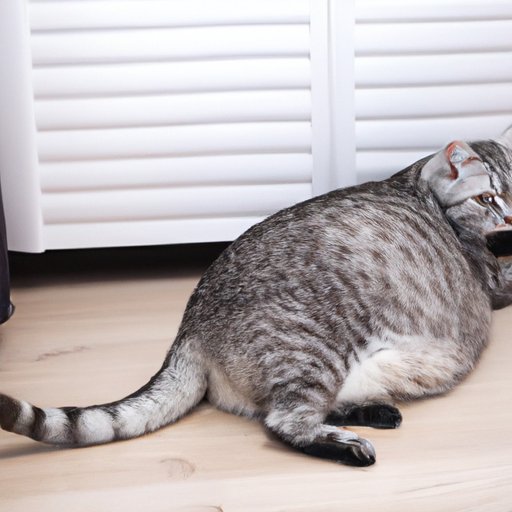
Introduction
As a cat owner, one of the most exciting things you can experience is the anticipation of kittens. But how do you know if your cat is pregnant? Many cat owners are unsure of what to look for and how to tell if their feline friend is carrying a litter. In this article, we will cover everything you need to know about how to tell if your cat is pregnant, from symptoms and tests to care during pregnancy and after birth.
Symptoms of Cat Pregnancy
There are several physical and behavioral symptoms that a pregnant cat may exhibit. Here are some of the most common signs:
Physical Symptoms
One of the most obvious signs that your cat is pregnant is physical changes. These can include:
Changes in appetite: Most pregnant cats will experience an increase in appetite.
Weight gain: A pregnant cat’s weight can increase by around 2-4 pounds.
Mammary gland development: The mammary glands of a pregnant cat will become larger and may leak milk.
Behavioral Symptoms
Along with physical symptoms, pregnant cats can also display changes in behavior. These can include:
Nesting behaviors: Your cat may start to look for a comfortable and secure place to give birth. This can manifest in behaviors such as kneading and rearranging blankets or bedding.
Increased affection: Some pregnant cats may become more affectionate than usual. They may seek out more attention from their owners and spend more time cuddling.
Restlessness: As the pregnancy progresses, your cat may become increasingly restless. This is typically a sign that labor is approaching.
Physical Examination for Pregnancy
If you suspect that your cat is pregnant, the first step is to take her to a veterinarian for a physical examination. During this exam, the veterinarian will be able to determine if your cat is pregnant, as well as estimate how far along she is.
Palpation
During a physical exam, the veterinarian may perform palpation to feel for fetal movement and size. This involves gently feeling your cat’s abdomen to determine if there are any lumps that could be kittens.
Ultrasound
Another option for detecting pregnancy is an ultrasound. This is a non-invasive imaging technique that uses sound waves to visualize the fetus. While an ultrasound can be more expensive than palpation, it is also more accurate and can give the veterinarian more information about the health of the fetuses.
Pregnancy Tests for Cats
In addition to a physical examination, there are also several types of pregnancy tests that can be used to determine if your cat is pregnant. These tests work by detecting hormone levels in urine or blood.
Urine Tests
One of the most common pregnancy tests for cats is a urine test. This involves collecting a sample of your cat’s urine and using a test kit to detect hormone levels. These tests can be done at home, but are generally less accurate than a physical examination.
Blood Tests
Blood tests can also be used to detect pregnancy in cats. These tests are typically more accurate than urine tests, but must be performed by a veterinarian.
Gestation Period and Stages of Pregnancy
The gestation period for cats is typically around 63-65 days. During this time, your cat will go through several stages of pregnancy.
Weeks 1-3
During the first few weeks of pregnancy, it can be difficult to tell if your cat is pregnant. At this stage, the fertilized eggs are traveling from the ovaries to the uterus and beginning to implant.
Weeks 4-6
At around 4 weeks, the fetuses will begin to develop limbs and organs. During this time, you may start to notice physical changes in your cat, such as weight gain and mammary gland development.
Weeks 7-9
During the final stage of pregnancy, your cat’s belly will become noticeably larger. She may also begin to display nesting behaviors and increased restlessness.
Care During Pregnancy
Caring for a pregnant cat involves providing appropriate nutrition and creating a comfortable environment. Here are some tips:
Diet: Your cat will need a high-quality, balanced diet during pregnancy. Be sure to consult with your veterinarian regarding appropriate nutrition for your cat.
Environment: Provide a comfortable and warm nesting area for your cat. This should be secluded and quiet, with easy access to food, water, and a litter box.
Veterinary check-ups: Regular veterinary check-ups are important during pregnancy to monitor your cat’s health, as well as the health of her fetuses.
Preparing for Birth
In the weeks leading up to your cat’s due date, it’s important to prepare for labor and delivery. Here are some tips:
Birthing space: Create a comfortable and secure space for your cat to give birth. This should be secluded and quiet, with easy access to food, water, and a litter box.
Complications: Be aware of potential complications that can arise during birth, such as difficult labor or the need for a cesarean section.
Veterinarian on call: Have a veterinarian on call in case of an emergency during labor and delivery.
Post-Natal Care
After the kittens are born, it’s important to provide care for both the mother cat and her offspring. Here are some tips:
Feeding: Your cat will need access to plenty of food and water during this time, and may require extra nutrition if she is nursing.
Socialization: Handle the kittens regularly to socialize them and get them used to human interaction.
Veterinary check-ups: It’s important to schedule regular veterinary check-ups for the kittens to ensure they are healthy and developing properly.
Conclusion
Knowing how to tell if your cat is pregnant is important for providing proper care to your furry friend and her kittens. By recognizing the symptoms of pregnancy, performing physical examinations and tests, and providing appropriate care during pregnancy and after birth, you can ensure that your cat and her offspring are healthy and happy.





